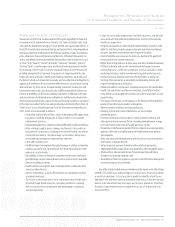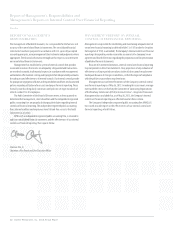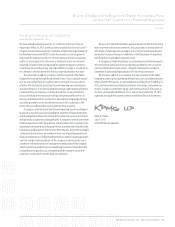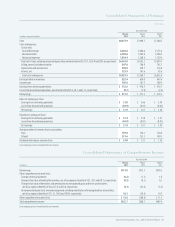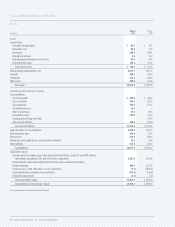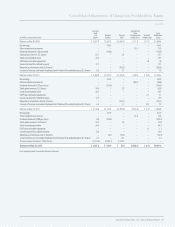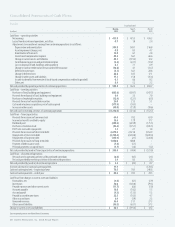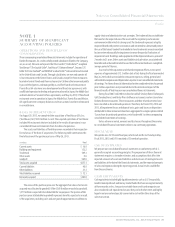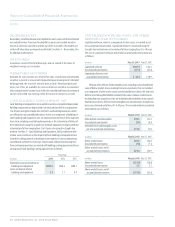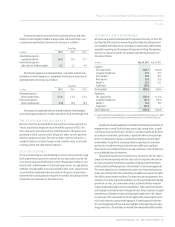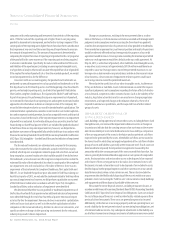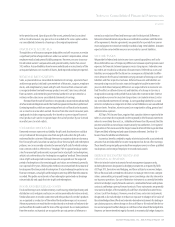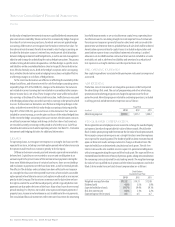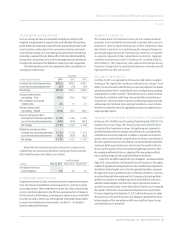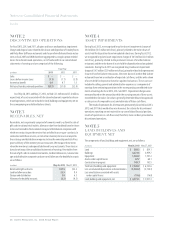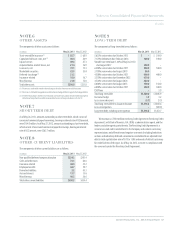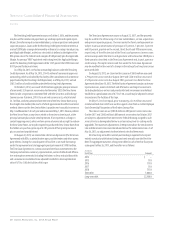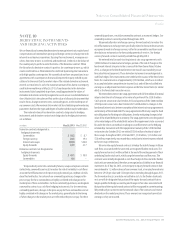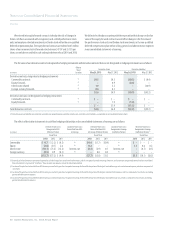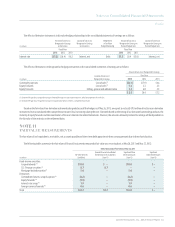Red Lobster 2013 Annual Report Download - page 45
Download and view the complete annual report
Please find page 45 of the 2013 Red Lobster annual report below. You can navigate through the pages in the report by either clicking on the pages listed below, or by using the keyword search tool below to find specific information within the annual report.
Notes to Consolidated Financial Statements
Darden
Darden Restaurants, Inc. 2013 Annual Report 41
Amortization expense associated with capitalized software and other
definite-lived intangibles included in depreciation and amortization in our
accompanying consolidated statements of earnings was as follows:
Fiscal Year
(in millions)
2013 2012 2011
Amortizationexpense–
capitalized software $6.4 $7.8 $7.7
Amortizationexpense–
other definite-lived intangibles 1.2 0.7 0.4
Amortization expense associated with above- and-below-market leases
included in restaurant expenses as a component of rent expense in our consoli-
dated statements of earnings was as follows:
Fiscal Year
(in millions)
2013 2012 2011
Restaurantexpense–
below-market leases $ 1.8 $ 1.8 $ 2.2
Restaurantexpense–
above-market leases (1.2) (0.5) (0.5)
Amortization of capitalized software and other definite-lived intangible
assets will be approximately $10.4 million annually for fiscal 2014 through 2018.
TRUST-OWNED LIFE INSURANCE
We have a trust that purchased life insurance policies covering certain of our
officers and other key employees (trust-owned life insurance or TOLI). The
trust is the owner and sole beneficiary of the TOLI policies. The policies were
purchased to offset a portion of our obligations under our non-qualified
deferred compensation plan. The cash surrender value for each policy is
included in other assets while changes in cash surrender values are included
in selling, general and administrative expenses.
LIQUOR LICENSES
The costs of obtaining non-transferable liquor licenses that are directly issued
by local government agencies for nominal fees are expensed as incurred. The
costs of purchasing transferable liquor licenses through open markets in juris-
dictions with a limited number of authorized liquor licenses are capitalized as
indefinite-lived intangible assets and included in other assets. Liquor licenses
are reviewed for impairment whenever events or changes in circumstances
indicate that the carrying amount may not be recoverable. Annual liquor license
renewal fees are expensed over the renewal term.
GOODWILL AND TRADEMARKS
We review our goodwill and trademarks for impairment annually, as of the first
day of our fourth fiscal quarter or more frequently if indicators of impairment
exist. Goodwill and trademarks are not subject to amortization and have been
assigned to reporting units for purposes of impairment testing. The reporting
units are our restaurant brands. Our goodwill and trademark balances are
allocated as follows:
(in millions)
May 26, 2013 May 27, 2012
Goodwill:
The Capital Grille $401.7 $401.8
LongHorn Steakhouse 49.5 49.5
Olive Garden (1) 30.2 30.2
Red Lobster (1) 35.0 35.0
Eddie V’s 22.1 22.1
Yard House 369.8–
Total Goodwill $908.3 $538.6
Trademarks:
The Capital Grille $147.0 $147.0
LongHorn Steakhouse 307.0 307.0
Eddie V’s 10.5 10.9
Yard House 109.3–
Total Trademarks $573.8 $464.9
(1) Goodwill related to Olive Garden and Red Lobster is associated with the RARE Hospitality International, Inc. (RARE)
acquisition and the direct benefits derived by Olive Garden and Red Lobster as a result of the RARE acquisition.
A significant amount of judgment is involved in determining if an indicator of
impairment has occurred. Such indicators may include, among others: a signifi-
cantdeclineinourexpectedfuturecashflows;asustained,significantdeclinein
ourstockpriceandmarketcapitalization;asignificantadversechangeinlegal
factorsorinthebusinessclimate;unanticipatedcompetition;thetestingfor
recoverabilityofasignificantassetgroupwithinareportingunit;andslower
growth rates. Any adverse change in these factors could have a significant
impact on the recoverability of these assets and could have a material impact on
our consolidated financial statements.
The goodwill impairment test involves a two-step process. The first step is a
comparison of each reporting unit’s fair value to its carrying value. We estimate
fair value using the best information available, including market information
and discounted cash flow projections (also referred to as the income approach).
The income approach uses a reporting unit’s projection of estimated operating
results and cash flows that is discounted using a weighted-average cost of capital
that reflects current market conditions. The projection uses management’s best
estimates of economic and market conditions over the projected period including
growth rates in sales, costs and number of units, estimates of future expected
changes in operating margins and cash expenditures. Other significant estimates
and assumptions include terminal value growth rates, future estimates of capital
expenditures and changes in future working capital requirements. We validate
our estimates of fair value under the income approach by comparing the values
to fair value estimates using a market approach. A market approach estimates
fair value by applying cash flow and sales multiples to the reporting unit’s oper-
ating performance. The multiples are derived from comparable publicly traded


